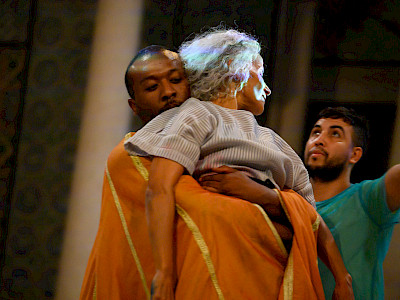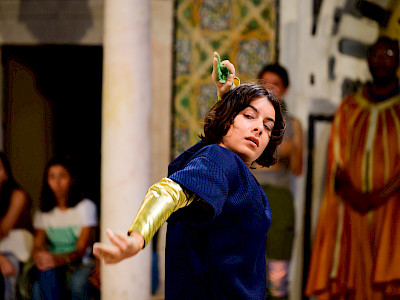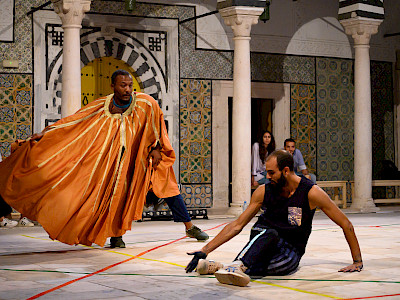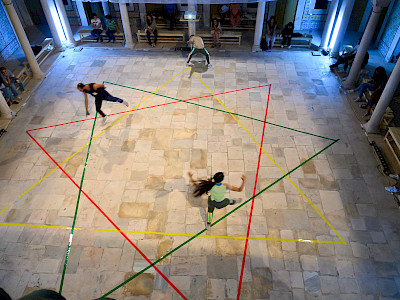16 — 18.05.2023
Eight dancers and a series of lines on the ground seem to trace the trajectories of a moving constellation we are about to observe. They move in a wonderful balance between extreme freedom and the idea of group unity, like leaves in the wind. They transmit to each other a song that becomes the element holding them together. In North Africa the crafts, science, philosophy, and culture of the Amazighs are passed down through story and language, dance and song. Libya celebrates this legacy. Radouan Mriziga’s dance performance is crafted as a landscape to which one can surrender. The dancers create a territory that cannot be conquered but instead asks to be contemplated. Among the different sounds we hear tarab music, a genre from the Maghreb region, characterised by long temporalities, intensity, and a restrained emotionality. It invites the listener to become lost in and carried by the music. Libya brings this same feeling of abandonment to dance and the unknown. The effect is amplified in the impressive hall of the Mercerie, with its decadent and sumptuous verticality. Libya’s blend of performance, choreography, scenery, tarab and rap generates a magnetic way of looking at dance, becoming a landscape of stories.
LIBYA
The idea of temporality in imperial history claims that there are discrete units of time. There is the past, which is over, and there is the present and the future. So how can we construct a non-imperial potential history together? How can we experience time as a single unit and a continuity of knowledge and universal flow? Revisiting History is not only about the past, but about the enormous possibilities of the present and the future. Written history excluded what was not written, so how can we share the part of our collective memories and histories that were left out of this academic historical frame?
The origin of the name Libya first appeared in an inscription of Ramesses II. Derived from the name by which a single Amazigh tribe was known to the ancient Egyptians, the name Libya was subsequently applied by the Egyptians and the Greeks to most of North Africa, West of Egypt, and the term Libyan to all of its Amazigh inhabitants. Most of what was written about the Imazighen in history books was by externals from the culture, but Imazighen themselves wrote about a lot of other things but their history. Even though they contributed heavily to the Mediterranean legacy through their arts, crafts, inventions, science, oral culture, philosophy, etc. they were completely left out of this socalled imperial history and marginalised in the imagining of the future in this region.
But despite thousands of years of invasions, conquests, and colonizations, Amazigh people have persistently transmitted their history and language through oral tales, poems, storytelling, songs, dances, and crafts. They might not have written their history, but they spoke it, they sang it, they danced it, they drew it and they weaved it.
So what could a proposal for an Amazigh epistemology be, while no books were written by the Amazigh to fixate their historiographical canon? Maybe such epistemology can be made of nothing else but poems, tales, choreography, body movements, objects, and tapestries. In a predominantly oral, pre-colonial North African culture, public performers played an essential role by relaying information from city to city, providing social, historical, and political commentary, and educating audiences.
For this creation, I want to exercise other narratives using the complexity of choreography as an opportunity to engage and elaborate nuanced shared history memories and epistemologies for an inclusive future from an Amazigh perspective of dealing with transmitting history through the body, art, oral heritage, and craft.
The performance structure explores the history of North African music along three main themes: percussion with the specific rhythms of Amazigh culture, Touareg
music with its mix of Arab and sub-Saharan instruments, and Arab-Andalusian music which has Arabic, European and Mediterranean influences.
The choreographic material can also be divided into three principle subjects. The first comes from the trilogy [Mriziga’s previous work: Ayur (2019), Tafukt (2020) and Akal (2021) – ed.] with Sondos, Maïté and Dorothée. Back then the material was mainly based on the texts we used. The second component is based on dances from North Africa. As most of the group in Libya have links with North Africa, we remembered and danced traditional dances or steps again that we knew, and put them together for the piece. For example the whole of Feteh’s solo is based on a mix of dances, from howwara and ahwash (south Morocco) to raggada (west Algeria) or alloui (east Morocco). The third part of the material is based on paintings found on rocks in North African deserts, specifically in Algeria or Libya. These prehistoric cave paintings show people dancing or doing everyday work. From the beginning of Libya, I wanted to incarnate these figures, to dance for them or share something with them. A big part of the performance is actually based on the story which came from looking at these desert paintings.
Libya is also very much influenced by the idea of landscape. There are three landscapes that I consider as being specific to the region: the sea, the mountain and the desert. During the performance we can see them projected in three videos on stage. These landscapes are connected to the different types of music I mentioned before. Tuareg music is rooted in the desert, the claps and very high voices are typically from the mountains, whereas Andalusian music is closely connected to the sea. These spaces are very meaningful at different levels; they hold poetry but also a kind of history of resistance too, since to resist is to preserve language, and preserving language maintains a social organisation.
I often work with the idea of several spaces that are simultaneously present. For instance, there is the performance space, the theatre (or specific site), and a third space, the space “that is not there”. For a long time in my work I was trying to create this third space using texts. With Libya I wanted to work further with this idea of a space “that is not there”. That’s why I decided to project these three spaces on video. They heavily influence the aesthetic of the performance and the link to its sources, but they also influence the emotional state of the audience.
Having the possibility to perform Libya at Mercerie – rather than in a theatre – allows the piece itself to be reshaped. We performed Libya in Tunis in a courtyard; a mix of European, North African, Middle Eastern and Mediter-ranean styles; a place that is old and fragile but at the same time has a strong character. I found the same atmosphere in Mercerie, a place blending different styles and histories. Somehow it brings together all the elements we were working on with Libya: a kind of fragility and a resistance. Something that resists destruction.
Radouan Mriziga
Presentation: Kunstenfestivaldesarts, Kaaitheater, Mercerie
Concept and choreography: Radouan Mriziga | With and by: Sondos Belhassen, Mahdi Chammem, Hichem Chebli, Bilal El Had, Maïté Minh Tâm Jeannolin, Senda Jebali, Feteh Khiari, Dorothée Munyaneza | Scenography: Radouan Mriziga | Costume design: Anissa Aidia and Lila John | Light design: Radouan Mriziga | Poem contribution: ‘And set them alight’ by Asmaa Jama | Assistance: Aïcha Ben Miled, Nada Khomsi, Khalil Jegham | Management: Something Great | International Distribution: Rui Silveira – Something Great | Tour Manager: Luca Napoli – Something Great
Production: A7LA5 vzw and L’Art Rue/Dream City | Coproduction: Festival de Marseille, L’Art Rue, De Singel, Abu Dhabi Cultural Foundation, C-Mine, Moussem Nomadic Arts Center
Residencies: Kaaitheater, L’Art Rue
With the support of: the Flemish Government





